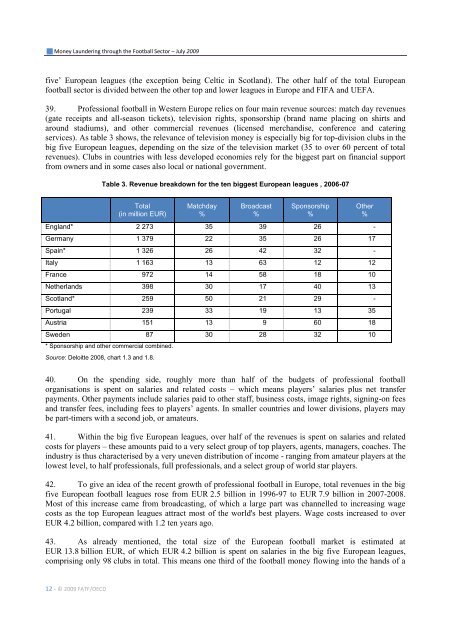Money Laundering through the Football Sector
Money Laundering through the Football Sector
Money Laundering through the Football Sector
Create successful ePaper yourself
Turn your PDF publications into a flip-book with our unique Google optimized e-Paper software.
<strong>Money</strong> <strong>Laundering</strong> <strong>through</strong> <strong>the</strong> <strong>Football</strong> <strong>Sector</strong> – July 2009<br />
five‟ European leagues (<strong>the</strong> exception being Celtic in Scotland). The o<strong>the</strong>r half of <strong>the</strong> total European<br />
football sector is divided between <strong>the</strong> o<strong>the</strong>r top and lower leagues in Europe and FIFA and UEFA.<br />
39. Professional football in Western Europe relies on four main revenue sources: match day revenues<br />
(gate receipts and all-season tickets), television rights, sponsorship (brand name placing on shirts and<br />
around stadiums), and o<strong>the</strong>r commercial revenues (licensed merchandise, conference and catering<br />
services). As table 3 shows, <strong>the</strong> relevance of television money is especially big for top-division clubs in <strong>the</strong><br />
big five European leagues, depending on <strong>the</strong> size of <strong>the</strong> television market (35 to over 60 percent of total<br />
revenues). Clubs in countries with less developed economies rely for <strong>the</strong> biggest part on financial support<br />
from owners and in some cases also local or national government.<br />
12 - © 2009 FATF/OECD<br />
Table 3. Revenue breakdown for <strong>the</strong> ten biggest European leagues , 2006-07<br />
Total<br />
(in million EUR)<br />
Matchday<br />
%<br />
Broadcast<br />
%<br />
Sponsorship<br />
%<br />
O<strong>the</strong>r<br />
%<br />
England* 2 273 35 39 26 -<br />
Germany 1 379 22 35 26 17<br />
Spain* 1 326 26 42 32 -<br />
Italy 1 163 13 63 12 12<br />
France 972 14 58 18 10<br />
Ne<strong>the</strong>rlands 398 30 17 40 13<br />
Scotland* 259 50 21 29 -<br />
Portugal 239 33 19 13 35<br />
Austria 151 13 9 60 18<br />
Sweden 87 30 28 32 10<br />
* Sponsorship and o<strong>the</strong>r commercial combined.<br />
Source: Deloitte 2008, chart 1.3 and 1.8.<br />
40. On <strong>the</strong> spending side, roughly more than half of <strong>the</strong> budgets of professional football<br />
organisations is spent on salaries and related costs – which means players‟ salaries plus net transfer<br />
payments. O<strong>the</strong>r payments include salaries paid to o<strong>the</strong>r staff, business costs, image rights, signing-on fees<br />
and transfer fees, including fees to players‟ agents. In smaller countries and lower divisions, players may<br />
be part-timers with a second job, or amateurs.<br />
41. Within <strong>the</strong> big five European leagues, over half of <strong>the</strong> revenues is spent on salaries and related<br />
costs for players – <strong>the</strong>se amounts paid to a very select group of top players, agents, managers, coaches. The<br />
industry is thus characterised by a very uneven distribution of income - ranging from amateur players at <strong>the</strong><br />
lowest level, to half professionals, full professionals, and a select group of world star players.<br />
42. To give an idea of <strong>the</strong> recent growth of professional football in Europe, total revenues in <strong>the</strong> big<br />
five European football leagues rose from EUR 2.5 billion in 1996-97 to EUR 7.9 billion in 2007-2008.<br />
Most of this increase came from broadcasting, of which a large part was channelled to increasing wage<br />
costs as <strong>the</strong> top European leagues attract most of <strong>the</strong> world's best players. Wage costs increased to over<br />
EUR 4.2 billion, compared with 1.2 ten years ago.<br />
43. As already mentioned, <strong>the</strong> total size of <strong>the</strong> European football market is estimated at<br />
EUR 13.8 billion EUR, of which EUR 4.2 billion is spent on salaries in <strong>the</strong> big five European leagues,<br />
comprising only 98 clubs in total. This means one third of <strong>the</strong> football money flowing into <strong>the</strong> hands of a


